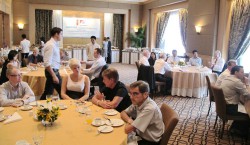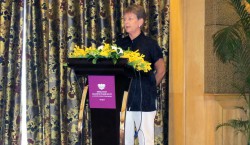“For those special situations, where a visa to Denmark is required here and now, we do have an unofficial fast track,” Lisa Schouboe, Head of the Visa Section at the Royal Danish Embassy in Bangkok explained in her presentation on Tuesday 23 March of the new visa handling system introduced in Thailand.
Photos from this event here
As examples of a situation when this could be invoked, she mentioned a patient in a hospital who needed fast transfer to Denmark and who had to be accompanied by two Thai doctors during the transfer. But it had also been applied for some to attend the climate meeting in Copenhagen in October last year, she added.
Lise Schouboe was speaking to around 23 Danish and Thai businessmen who attended the breakfast meeting arranged by Danish Thai Chamber of Commerce specifically on the subject.
Pressured by President Peter Romhild to comment on another scenario where a Thai businessman of a major Thai company on a Friday realizes that he has to be in Copenhagen on Monday for an important meeting, Lise Schouboe cautiously answered:
“You could call the consul..”
Peter Romhild recalled a situation, where he himself recently had to go to Australia and had forgotten to get a visa. But he didn’t need to rush any further than to his PC.
“I went online, and 2 minutes later I was granted a visa, which I could print out and bring with me to the airport. Given the time and age, that we live in, where more and more is available on the internet, isn’t possible that somewhere, somehow you are not doing this right?”
“I don’t like criticism,” Lise Schouboe reflected.
“I really like my job and I am quite proud of the way we handle the many applications we receive. In an uncomplicated case, you can be granted a visa within one week and that is actually quite good,” she said.
She added that maybe the online system, currently being tested at the consulate general in New York would be a success and if so, it could be applied in Bangkok some 6 – 8 months later. The tests service in New York would run for a year before it would be evaluated.
Outsourcing the handling
The latest improvement to the system is the outsourcing of receiving the visa applications. This started as an experiment, when Lise Schouboe was working at the Embassy in Delhi – incidentally the Ambassador was at that time the current Danish Ambassador to Thailand Michael Sternberg.
The experiment in Delhi turned out to be so successful that the Danish Ministry for Foreign Affairs decided to implemented this at most of the Danish embassies elsewhere in the world. The new Visa Application Centre in Bangkok is operated by VFS Global Private Ltd. as an outsource partner.
The location of the Center in the Amarin Tower was found by the staff of the Danish Embassy, Lise Schouboe explained. The convenience of the location was the main advantage and fortunately VFS approved it.
Last year, the Danish Embassy processed more than 5.000 visa and stay permits, which makes this embassy one of the busiest worldwide.
A visa is a permission to stay in the Schengen area for 90 days. The two most common types of visa are the business visa and the “C” visa which are for tourist or family visits. Applications for resident permits and work permits are not technically visa applications and applications for this will always be forwarded for processing in Copenhagen.
Of the 5000 applications received last year, about a 1000 applications were for resident permits and work permits. Of the remaining 4000 applications, 2000 persons were given a visa by the embassy without forwarding the application to Copenhagen – a so called “bonafide” visa.
In the remaining 2000 cases, where embassy had been in doubt, the application had been forwarded to Copenhagen. Only some of these applicants had been denied a visa.
Lise Schouboe also mentioned that last year, the embassy had started issuing visas valid for up to 3 years with multiple entries. These were granted on a case by case basis. But the maximum number of days a foreigner can stay on a visa inside the Schengen area remains max. 90 days per any 6 months period, she added.
Sweden and maybe Norway to follow
In mid May this year, Sweden will also outsource its visa handling procedure in Bangkok to the same VFS company as Denmark has contracted. The Norwegian embassy has currently put out a tender for outsourcing the visa handling. If VFS also wins this tender, which Lise Schouboe said she personally hoped it will, the visa handling center in Amarin Tower will be a central location for a substantial number of visa applications to the Nordic countries. Currently, the Swedish embassy handles 14.000 applications for visa to Sweden per year.
In the current phase, the only thing the new center does with the Danish visas is to receive the application and the payment for the fee. Next morning, the stack is handed over to the staff at the Danish Embassy who takes care of the processing as before. Later By the end of this year, the VFS office will also start keying in the data into the system, which is today done at the Embassy. This phase awaits the completion of the software that is being developed for this purpose.
“The service today is better than before. There are no waiting lists anymore. You don’t need to make an appointment to submit your application – you can walk in from the street and apply for the visa.”
The total processing time will later be shortened down by this outsourcing, she predicted.
On 5 April this year, the Schengen countries will introduce a new visa codex setting the maximum processing time for all visa applications to 15 days.
“This will be a huge challenge, especially for those visa applications that we submit to the immigration service in Copenhagen,” she added.
It is currently being considered by the authorities in Denmark, whether certain approved travel agencies should in the future be granted permission to handle the paper work related to their clients’ visa applications. If this becomes the case, it may further facilitate the issuing of simple tourist visas to a big part of the 5000 visitors.
Biometric visas as early as next year?
The Schengen area today comprises 24 countries. Each have the same basic requirements that must be submitted when applying for a visa while some have additional requirements.
“In 2011 or 2012 biometric registration wil become part of what will be required when applying for a Schengen visa for all the countries,” she said.
“Eye scanning will not yet be required, but fingerprints will be taken. The VFS centre is already prepared for this situation with a special section where these fingerprints will be collected,” she explained.
Still, for biometrics to be part of the application, it means people have to be physically present at some point during the application procedure, which was a stumbling block if in the long term an application should be possible to submit online.
Lise Schouboe regretted the little feed back the embassy received from the police regarding violators of the visas that the Embassy was granting. But she confirmed that it was partly due to the fact that there was no central clearing point, where the Schengen countries could see who entered the area and where and who left it – or overstayed. Once a person had been granted a visa it was not known if, when and where the applicant entered the Schengen area and if, when and where the person left the Schengen area again.
“But when we process visa applications, we always check if the applicant has previously had a visa and if so if the person has ever overstayed the visa, that we granted,” she added.












